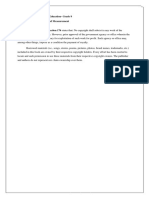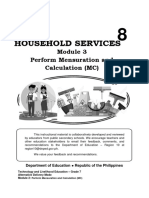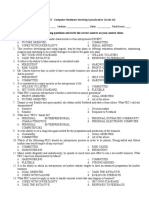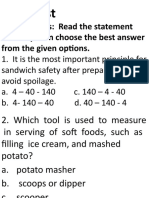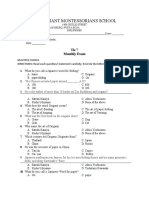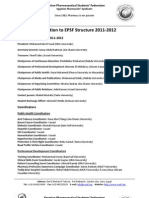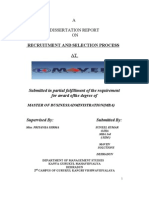Quarter 3 Final Examination in Tle 10 Handicraft
Quarter 3 Final Examination in Tle 10 Handicraft
Uploaded by
MARY JOYCE MONIQUE ELEGARCOCopyright:
Available Formats
Quarter 3 Final Examination in Tle 10 Handicraft
Quarter 3 Final Examination in Tle 10 Handicraft
Uploaded by
MARY JOYCE MONIQUE ELEGARCOOriginal Description:
Original Title
Copyright
Available Formats
Share this document
Did you find this document useful?
Is this content inappropriate?
Copyright:
Available Formats
Quarter 3 Final Examination in Tle 10 Handicraft
Quarter 3 Final Examination in Tle 10 Handicraft
Uploaded by
MARY JOYCE MONIQUE ELEGARCOCopyright:
Available Formats
Republic of the Philippines
Department of Education
Region IV-B MIMAROPA
Division of Occidental Mindoro
San Jose South District
ILING NATIONAL HIGH SCHOOL
Quarter 3 FINAL EXAMINATION in TLE 10 – HANDICRAFT (Papercraft)
Test I. Modified TRUE or FALSE
Directions: Read the following statements below. Write the words “FOR THE GO!” if the statement is correct and “VERY WRONG
YAN!” if the statement is incorrect. Write your answer on your ANSWER SHEET.
1. Origami originated from Japan during the seventh century.
2.At the onset of the Showa period, Origami, had rapidly passed into oblivion
3.Origami was known to have been created for the elite for their paper folding in writing letters
4. Washi wasa type of paper possessing dual qualities of resilient sturdiness and softness which prevented tearing when it was handled
5. Origami has been known for children’ s amusement only.
6. Check that the paper you are folding is exactly a square.
7. Do not fold against a soft surface, such as a carpet, your lap or bedsheets. Fold against a hard surface ,such as a large hardback
book or a table.
8. Crease slowly, firmly, and accurately. Form the early creases with particular care – if they are incorrect place, all the later, smaller
creases will be difficult to place accurately and will look messy.
9. Read the instruction and follow the symbol on each step. Many mistakes are made by ignoring written instructions or by not
following all the written instructions on a step, particularly during complex maneuvers.
10. The instruction and symbols on one step will create a shape which looks like the next step but stripped of its symbols. So, you must
always look ahead to the next step to see what shape you are trying to make. Never look at steps in isolation, but see them as being
interconnected, like links in a chain.
Test II. MULTIPLE CHOICE
Directions: Read the following statements below carefully. Choose the letter of the correct answer by shading the rectangle. Write your
answer on your ANSWER SHEET.
11. The Japanese word "origami" itself is a compound of two smaller Japanese words: "_____", meaning to fold, and "_____",
meaning paper.
A. oki and kami B. opi and kani C. ori and kami D. ori and kani
12. It is the technique of paper making introduced into Japan by _______ during the early seventh century.
A. America B. China C. Germany D. Malaysia
13. Which of the following is the unique and distinct type of Japanese paper kindled many forms of cultural creativity, among them
origami?
A. Noshi B. ori C. tatamigami D. Washi
14. The word "origami" was a direct translation of the German word "_________________", brought into Japan with the Kindergarten
Movement around 1880.
A. Papierfalten B. Paperfaltein C. Papierpalten D. Paperpaltein
15. Which of the following period does mass-produced, low-priced paper came to be widely used by the people?
A. Edo Period B. Genruko Period C. Showa Period D. None of these!
16. In what period does origami of the crane and several varieties of boats used as designs on clothing became fashionable, and it was
also reproduced with great frequency in Ukiyoe prints.
A. Edo Period B. Genruko Period C. Showa Period D. None of these!
17. In this period the art has rapidly passed into oblivion, but a vestige of its former use can still be seen in the noshi, a decoration of
folded red and white paper attached to a gift.
A. Edo Period B. Genruko Period C. Showa Period D. None of these!
18. Which of the following statements is TRUE?
A. They were not only a form of children's amusement, but also a form intended for adults.
B. They were only a form of children's amusement, but also a form intended for adults.
C. They were only a form of children's amusement, but not a form intended for adults.
D. They were not only a form of children's amusement, and not a form intended for adults.
19. In what century does technique of paper making was introduced into Europe producing a distinct form of origami?
A. tenth century B. eleventh century C. twelfth century D. thirteenth century
20. Which of the following is a kind of wrapper used for formal occasions?
A. orikata B. orimono C. tatamigami D. tsutsumi
Test III. MATCHING TYPE
Directions: Match column B to column A. Write the letter of the correct answer on the space provided on your answer sheet.
COLUMN A COLUMN B
21. A. Fold and unfold, i.e first fold in the direction of the normal arrow, and then fold
back in the direction of the hollow arrow.
22. B. This shows the white and coloured side, like standard origami paper.
23. C. Unfold a part of the model in the shown direction.
D. Thick lines show either raw edges or edges resulting from fold.
24.
E. Fold behind (mountain Fold) and unfold, creating a mountain crease line.
25.
F. Thin grey lines show crease lines which are the result of prior folds.
26. G. Fold and unfold, creating a crease line
H. Dotted lines show that are hidden behind layers of paper.
27.
I. Fold behind, i.e. make a mountain fold.
28.
J. Dash lines shows that the fold is supposed to be valley fold.
29.
K. Dash and dotted line shows that the fold is supposed to be a mountain fold.
30. Sometimes you will find this line with a single dot.
B1. L. Fold the paper where shown is usually a valley fold but uses for other fold as
well
B2.
Test IV. IDENTIFICATION
Directions: Identify the following pictures below. Write your answer on the space provided on your answer sheet.
A. paper B. taco fold C. hamburger fold D. scissors E. burito fold F. mountain fold
G. valley fold H. knife/cutter I. hotdog fold J. shutter fold \
31. 34. 37. 40.
32. 35. 38.
33. 36. 39.
You might also like
- Max Sørensen (Eds.) - Manual of Public International Law-Palgrave Macmillan UK (1968)No ratings yetMax Sørensen (Eds.) - Manual of Public International Law-Palgrave Macmillan UK (1968)986 pages
- 1.simple Interview Evaluation Form TemplateNo ratings yet1.simple Interview Evaluation Form Template2 pages
- 3rd Quarter Summative Test in CCS For Week 1 - 2 Grade10100% (2)3rd Quarter Summative Test in CCS For Week 1 - 2 Grade101 page
- 1st Quarter Examination in Household Services 10No ratings yet1st Quarter Examination in Household Services 104 pages
- Design of Basketry Product-Week 3 4th Quaarter100% (1)Design of Basketry Product-Week 3 4th Quaarter29 pages
- First Quarter Exam in Dressmaking Grade-10No ratings yetFirst Quarter Exam in Dressmaking Grade-103 pages
- 2nd Quarter Examination in TLE 10 HandicraftNo ratings yet2nd Quarter Examination in TLE 10 Handicraft2 pages
- 3rd Periodical Test Mapeh 10 Test QuestionnaireNo ratings yet3rd Periodical Test Mapeh 10 Test Questionnaire6 pages
- Compilation of Tools, Equipments and Materials: Use in Fashion Accessories in The PhilippinesNo ratings yetCompilation of Tools, Equipments and Materials: Use in Fashion Accessories in The Philippines44 pages
- System of Measurement: Technology and Livelihood Education-Grade 9 Quarter 2, Week 2No ratings yetSystem of Measurement: Technology and Livelihood Education-Grade 9 Quarter 2, Week 26 pages
- Grade 10: Technology and Livelihood Education Household Services100% (1)Grade 10: Technology and Livelihood Education Household Services12 pages
- Household Services: Perform Mensuration and Calculation (MC)No ratings yetHousehold Services: Perform Mensuration and Calculation (MC)43 pages
- Department of Education: Schools Division of Ozamiz City100% (2)Department of Education: Schools Division of Ozamiz City3 pages
- Department of Education: Exploratory Course - Beauty Care Nail Care Services Summative TestNo ratings yetDepartment of Education: Exploratory Course - Beauty Care Nail Care Services Summative Test7 pages
- SLHT G9 BEAUTY CARE 3rd Quarter WEEK 1 PDFNo ratings yetSLHT G9 BEAUTY CARE 3rd Quarter WEEK 1 PDF7 pages
- Techincal Drawing 7 1st Quarter Examination100% (1)Techincal Drawing 7 1st Quarter Examination2 pages
- Handling, Transporting Materials/Equipment and Maintaining A Clean and Safe Work SiteNo ratings yetHandling, Transporting Materials/Equipment and Maintaining A Clean and Safe Work Site10 pages
- Learning Activity Sheet No. 1.2: (Tle - Hedm9-12Triiia-H-9)No ratings yetLearning Activity Sheet No. 1.2: (Tle - Hedm9-12Triiia-H-9)6 pages
- Tle10 - He - Cookery - q2 - Mod6 - Preparingandcookingseafooddishes - v3 (91 Pages) - 2No ratings yetTle10 - He - Cookery - q2 - Mod6 - Preparingandcookingseafooddishes - v3 (91 Pages) - 292 pages
- Examination Booklet Tle Handicraft Grade 1050% (2)Examination Booklet Tle Handicraft Grade 108 pages
- First Periodical Test in Handicraft 8: Old Cabalan Integrated School100% (2)First Periodical Test in Handicraft 8: Old Cabalan Integrated School3 pages
- A. Directions: Read The Statement Carefully Then Choose The Best Answer From The Given Options100% (1)A. Directions: Read The Statement Carefully Then Choose The Best Answer From The Given Options8 pages
- Music Quarter 3 Philippine Contemporary Music LAS 1.2: New Music Composers100% (1)Music Quarter 3 Philippine Contemporary Music LAS 1.2: New Music Composers8 pages
- Quarter 2 Weeks 1 To 5: Summative Test Grade 10 EnglishNo ratings yetQuarter 2 Weeks 1 To 5: Summative Test Grade 10 English4 pages
- Self Learning Kit - Science7 - Q4 - WEEK-1No ratings yetSelf Learning Kit - Science7 - Q4 - WEEK-111 pages
- Philippine Nursing Act of 2002 (R.A. No. 9173)No ratings yetPhilippine Nursing Act of 2002 (R.A. No. 9173)85 pages
- Iii&Iv Year Course Structure (R15 Regulations) FOR B.Tech - Electrical and Electronics Engineering W.E.F. 2015-2016 ADMITTED BATCHNo ratings yetIii&Iv Year Course Structure (R15 Regulations) FOR B.Tech - Electrical and Electronics Engineering W.E.F. 2015-2016 ADMITTED BATCH98 pages
- Certificate III in Customer Engagement: Delivery Mode Course DurationNo ratings yetCertificate III in Customer Engagement: Delivery Mode Course Duration2 pages
- Introduction To EPSF Structure 2011-2012No ratings yetIntroduction To EPSF Structure 2011-20122 pages
- The Basics of Platos Allegory of The CavNo ratings yetThe Basics of Platos Allegory of The Cav16 pages
- Tasks Involved: Discussion With Decision Maker(s) Interviews With Experts Secondary Data Analysis Qualitative ResearchNo ratings yetTasks Involved: Discussion With Decision Maker(s) Interviews With Experts Secondary Data Analysis Qualitative Research15 pages
- Letter From CM Kenyan McDuffie To Mayor Bowser Outlining Budget Requets and Priorities For FY19No ratings yetLetter From CM Kenyan McDuffie To Mayor Bowser Outlining Budget Requets and Priorities For FY195 pages
- Krishnamurthi Explained - A Critical StudyNo ratings yetKrishnamurthi Explained - A Critical Study15 pages
- M Channon Resume 2023 For Weebly - MchannonNo ratings yetM Channon Resume 2023 For Weebly - Mchannon3 pages

























